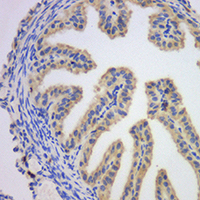LncRNA GClnc1 may contribute to the progression of ovarian cancer by regulating p53 signaling pathway

Submitted: 23 July 2020
Accepted: 4 September 2020
Published: 10 November 2020
Accepted: 4 September 2020
Abstract Views: 622
PDF: 515
HTML: 7
HTML: 7
Publisher's note
All claims expressed in this article are solely those of the authors and do not necessarily represent those of their affiliated organizations, or those of the publisher, the editors and the reviewers. Any product that may be evaluated in this article or claim that may be made by its manufacturer is not guaranteed or endorsed by the publisher.
All claims expressed in this article are solely those of the authors and do not necessarily represent those of their affiliated organizations, or those of the publisher, the editors and the reviewers. Any product that may be evaluated in this article or claim that may be made by its manufacturer is not guaranteed or endorsed by the publisher.
Similar Articles
- E. Negrato, M. Vascellari, F. Capolongo, G. Binato, L. Da Dalt, M. Boscolo Papo, G. Gioacchini, O. Carnevali, D. Bertotto, G. Radaelli, F. Pascoli, Expression of 8-OHdG in Zosterisessor ophiocephalus from the Venetian lagoon, Italy , European Journal of Histochemistry: Vol. 57 No. 1 (2013)
- A. Cataldi, S. Zara, M. Rapino, M. Zingariello, V. di Giacomo, A. Antonucci, p53 and telomerase control rat myocardial tissue response to hypoxia and ageing , European Journal of Histochemistry: Vol. 53 No. 4 (2009)
- E. Varricchio, M.G. Russolillo, L. Maruccio, S. Velotto, G. Campanile, M. Paolucci, F. Russo, Immunological detection of m- and µ-calpains in the skeletal muscle of Marchigiana cattle , European Journal of Histochemistry: Vol. 57 No. 1 (2013)
- Kazuhiko Hashimoto, Yutaka Oda, Fumihisa Nakamura, Ryosuke Kakinoki, Masao Akagi, Lectin-like, oxidized low-density lipoprotein receptor-1-deficient mice show resistance to age-related knee osteoarthritis , European Journal of Histochemistry: Vol. 61 No. 1 (2017)
- Brigitta Bonaldo, Antonino Casile, Martina Bettarelli, Stefano Gotti, GianCarlo Panzica, Marilena Marraudino, Effects of chronic exposure to bisphenol A in adult female mice on social behavior, vasopressin system, and estrogen membrane receptor (GPER1) , European Journal of Histochemistry: Vol. 65 No. s1 (2021): Special Collection on Advances in Neuromorphology in Health and Disease
- ChenHui Zhu, LiJuan Lin, ChangQing Huang, ZhiHui Wu, Activation of Hedgehog pathway by circEEF2/miR-625-5p/TRPM2 axis promotes prostate cancer cell proliferation through mitochondrial stress , European Journal of Histochemistry: Vol. 68 No. 4 (2024)
- N. Kiga, I. Tojyo, T. Matsumoto, Y. Hiraishi, Y. Shinohara, S. Makino, S. Fujita, Expression of lumican and fibromodulin following interleukin-1 beta stimulation of disc cells of the human temporomandibular joint , European Journal of Histochemistry: Vol. 55 No. 2 (2011)
- Ermanna Turano, Federica Virla, Ilaria Scambi, Sylwia Dabrowska, Oluwamolakun Bankole, Raffaella Mariotti, Adipose mesenchymal stem cells-derived extracellular vesicles exert their preferential action in damaged central sites of SOD1 mice rather than peripherally , European Journal of Histochemistry: Vol. 68 No. 3 (2024)
- F Cappello, A Palma, A Martorana, Biological aggressiveness evaluation in prostate carcinomas: immunohistochemical analysis of PCNA and p53 in a series of Gleason 6 (3+3) adenocarcinomas , European Journal of Histochemistry: Vol. 47 No. 2 (2003)
- A. Mangas, J. Yajeya, N. González, I. Ruiz, M. Geffard, R. Coveñas, 3-hydroxi-anthranilic acid is early expressed in stroke , European Journal of Histochemistry: Vol. 60 No. 4 (2016)
<< < 24 25 26 27 28 29 30 31 32 33 > >>
You may also start an advanced similarity search for this article.

 https://doi.org/10.4081/ejh.2020.3166
https://doi.org/10.4081/ejh.2020.3166










